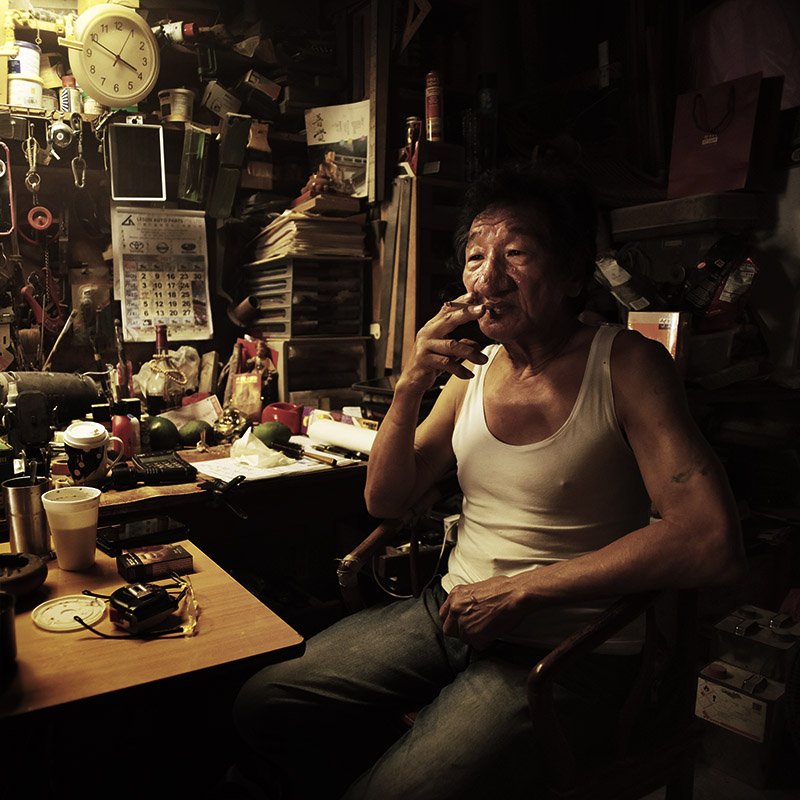Using GF50mm for Portraiture
Portrait of Mr. Phua: Making Space Where There Is None — with the GF 50mm
Some portraits stay with you long after the shutter clicks. This one — of SK Phua, the master craftsman carpenter in his impossibly packed workshop — is one of them.
The space was tight. Every inch of wall, floor, and bench was covered with tools, scraps, wires, and memories. The kind of place where even breathing feels like you might knock something over. It wasn’t a studio. It wasn’t staged or set-dressed. It was real. Every tool has a story to tell and is a part of Phua’s life’s work and passion. And I wanted to respect that.
Which is exactly why I brought the Fujifilm GFX 50S II and the GF 50mm f/3.5.
When Space Is Tight, Less Camera Is More
Shooting medium format in a cramped location is usually a recipe for frustration. Big lenses, heavy rigs, limited movement. But the GF 50mm changes that. It’s compact — even elegant in its simplicity. It doesn’t dominate the space, and more importantly, it doesn’t dominate the person.
Mr. Phua didn’t flinch. He didn’t feel like he was being examined or documented. The camera didn’t intrude. It simply observed.
That’s a quality I value immensely in portraiture — the ability for the gear to disappear, so the moment can breathe.
Wide Enough, But Still Intimate
The 50mm focal length (around 40mm in 35mm full-frame equivalent) gave me exactly what I needed here. It let me include the organized chaos of his shop — every tape roll, tool, and scrap of technique and craft — while still keeping Mr. Phua the emotional center of the frame.
He’s there, strong and proud, slightly off-center, laughing mid-gesture — and yet all around him, the environment tells its own story. That balance is hard to strike. Too wide, and the subject gets lost. Too tight, and you lose the context. This lens nailed it.
A Lens That Let Me Get Close
I didn’t have room to back up. I was practically against the whirling blades of an industrial sized standing fan. But the GF 50mm let me step into the scene rather than hover outside it. That proximity matters. It lets the portrait feel personal, not posed.
Mr. Phua’s joy — that cheeky grin, those flexed arms — none of it was directed or prompted. It was him, being himself. I just happened to be there with a camera that was small enough, quiet enough, and quick enough to keep up.
Rendering That Respects the Mood
The light in his shop was harsh overhead fluorescents and one key light I managed to squeeze in (hand held by another extraordinary photographer buddy who you can find here…). And yet, the GFX sensor paired with the GF 50mm handled it with grace. The textures — skin, wood, metal, even the sawdust — all came through with a softness that didn’t sanitize the scene, just made it feel human.
There’s a dignity in the way this camera and lens render a portrait. No over-sharpened gimmicks. No artificial pop. Just honest detail, beautifully preserved.

Final Thoughts
This photo of Mr. Phua reminds me why I do what I do. About connecting. About making the most of the space, the light, the mood — and the person standing right there in front of you.
The GF 50mm it helps me move freely, shoot confidently, and stay emotionally present in moments like these.
And that makes it one of the most powerful tools in my kit.
 Previous post
Why GF 50mm is the Perfect GFX Lens
Previous post
Why GF 50mm is the Perfect GFX Lens
 Next post
The Fuji X-E3 is not a cat
Next post
The Fuji X-E3 is not a cat

